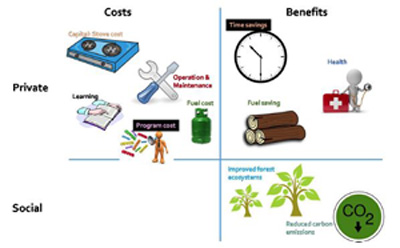New Cost Benefit Analysis for Clean Cooking Interventions
Last year, the Copenhagen Consensus released an analysis of the benefits and costs of different cooking technologies which was widely acknowledged to be overly optimistic in terms of the achievable health benefits of clean cooking (Larsen 2015 – for more details on this earlier analysis see Air Pollution Assessment Paper). In response, the Alliance committed to supporting a more robust, updated analysis of the benefits and costs of different cooking technologies, based on newly available data emerging from such research efforts.
Drs. Marc Jeuland and Jie-Sheng Tan Soo from Duke University have recently completed this updated analysis: Analyzing the costs and benefits of clean and improved cooking solutions. In brief, they developed a complex model of around 30 parameters to estimate the net benefits of switching from traditional cooking to various cleaner and more efficient cooking technologies. Both global and South Asia estimates are provided. Their results suggest that while it is generally beneficial for a household to switch from traditional to improved cookstoves, there is great variability in contextual and household level factors influencing adoption of clean cooking and its benefits.
- From a private perspective, time and health contribute strongly to net benefits at mean parameter values. The largest costs are the stove and promotion program costs, and, for those stoves requiring commercial fuels, fuel costs.
- All options look more attractive from a social perspective, especially if black carbon, organic carbon and carbon monoxide emissions of traditional stoves are included.
Simulation data can be provided on request. info@cleancookstoves.org

